Osteochondrosis of the cervical spine is chronic illness with alternating periods of remission and exacerbation. Moreover, the aggravation of the situation may come at the most unexpected moment. In such cases, treatment with pills and ointments cannot provide a quick and necessary analgesic effect, therefore the only right choice- these are injections for osteochondrosis of the cervical spine.
Such intensive therapy allows, in the shortest possible time, to effectively relieve the patient of unbearable pain and quickly return to everyday life, because with the help of injections, the drug is delivered directly into the systemic circulation, from where it quickly reaches desired point applications.
This article will focus on what injections are used for cervical osteochondrosis, their mechanism of action, indications and prohibitions for use.
Benefits of injections
Injection of drugs for osteochondrosis of the cervical spine has a number of advantages over tablet forms of drugs:
- High efficiency and speed of action. When the drug is administered intramuscularly or intravenously, it quickly enters the systemic circulation and immediately reaches the nerve endings, muscles and other damaged tissues in osteochondrosis. If the patient takes a pill, then it must first pass through the digestive tract to small intestine where absorption takes place. Moreover, not the entire dose enters the bloodstream. active substance and not immediately, for example, if you take a pill on a full stomach, then only 50% of the medicine will enter the bloodstream. Thus, the effect occurs in at least 30-40 minutes, and it is not as pronounced as in injections.
- The dose can be accurately determined. The entire amount of the medicine in the injections will definitely hit the destination, which cannot be said about the pills.
- The administration of drugs in injections does not cause side effects from the gastrointestinal tract, which is very important in patients with background gastroenterological pathologies.
- Intravenous injections allow you to evenly administer medications for a long time, which provides a therapeutic concentration of the substance in the blood at a constant level and well eliminates the symptoms of osteochondrosis of the cervical spine.
The main groups of injections
You need to know that the treatment cervical osteochondrosis injections is only symptomatic and is used as an ambulance for exacerbation of the disease. This technique is not suitable for continuous therapy.
Most often, with an exacerbation of osteochondrosis of the cervical spine, injections from the following groups are used:
- analgesics;
- non-steroidal anti-inflammatory;
- muscle relaxants;
- glucocorticoid hormones.
Pain relief injections
Analgesics are prescribed to all patients without exception with exacerbation of osteochondrosis, since not a single case proceeds without pain, and sometimes it is so strong that even narcotic painkillers have to be prescribed in a short course. It must be remembered that analgesics do not cure the disease itself, they only relieve pain, which is the main symptom of pathology.
Most often, painkillers are injected intramuscularly 1-2 times a day or more (this depends on the severity of the pain syndrome). The following drugs are used:
- Analgin 2 ml;
- Baralgin 5 ml;
- Dexalgin 2 ml.
All of these injections are non-narcotic analgesics. A decrease in pain is noted within 10-15 minutes after administration, reaches a maximum after 1 hour, and the effect lasts from 4 to 8 hours.
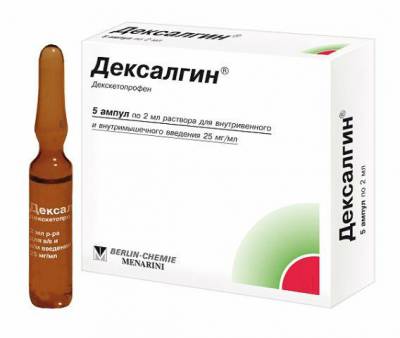
Dexalgin is an effective pain reliever
It is possible to increase the effectiveness of analgesic injections if they are administered not intramuscularly, but intravenously as part of a lytic mixture. Such a dropper is injected for 30-40 minutes, it relieves pain well.
NSAIDs
Non-steroidal anti-inflammatory drugs are by far the most widely used in medicine. There are practically no diseases for which they would not be indicated. Although they are part of the over-the-counter group, only a doctor should prescribe them, since there are many contraindications and side effects.
NSAIDs eliminate pain, like analgesics, but in addition, they also affect the pathogenesis of exacerbations of osteochondrosis - they have a good anti-inflammatory effect, which leads to attenuation of inflammation in the area of damaged spinal roots and stabilization of the disease.
There are many drugs from this group, but most often they are used to relieve exacerbations of osteochondrosis:
- Diclofenac (Dikloberl, Diklak, Almiral, Voltaren);
- Ibuprofen;
- Meloxicam (Movalis, Revmoxicam);
- Aceclofenac (Aertal);
- Ksefokam;
- Ketonal;
- Ketorolac.
Important! The most common complication and side effect of drugs from the NSAID group is damage to the gastric mucosa and the development or exacerbation of peptic ulcer disease, and this does not depend on the fact that the drug was administered in injections, and not in tablets. Therefore, patients with such problems should not use drugs from this group, so as not to provoke bleeding.
Muscle relaxants
Prescribing drugs that eliminate muscle spasm (in this case, skeletal muscles) is pathogenetically justified. The fact is that any exacerbation of osteochondrosis is accompanied by a reflex spasm of skeletal muscles in the place inflammatory process(a kind of protective reaction of the body, which turns into a pathological one). Spasmodic muscles contribute to increased pain, increased swelling and inflammation, and impairment of blood circulation. Therefore, by eliminating this factor, you can help the patient to get back on his feet much faster.

Mydocalm effectively eliminates muscle spasm and reduces pain in osteochondrosis
For this purpose, injections are used, which are administered intramuscularly, capable of selectively acting on the desired muscle groups. These drugs differ from all known antispasmodics, for example, no-shpy, because, unlike them, they do not relax smooth muscles internal organs, and skeletal muscle.
The following drugs are used:
- Tizalud;
- Sirdalud.
The effective dose is 1 ml, injections are injected 2 times a day, in the future you can switch to taking similar tablets.
Glucocorticoid hormones
Despite the fact that glucocorticoid hormones effectively relieve pain and inflammation, there are differing opinions on the appropriateness of their appointment among specialists. But, as practice shows, they are often prescribed as part of complex therapy, monotherapy is not used. So Dexamethasone or Hydrocortisone is injected intravenously as part of a lytic mixture (together with pain relievers).
There are also complex preparations containing GCS that do not need to be mixed. Attention should be paid to Ambene injections. The course of treatment consists of 3 doses of the drug, which are administered every other day. One dose is 2 injections (ampoule A and B). Sometimes this alone is enough to relieve the most persistent pain syndrome and get rid of an exacerbation. Ambene contains Dexamethasone, Lidocaine, Vitamin B 12, Phenylbutazone, NSAIDs and water for injection. We can say that one dose of this medicine contains all the necessary medicines to eliminate the exacerbation of osteochondrosis.
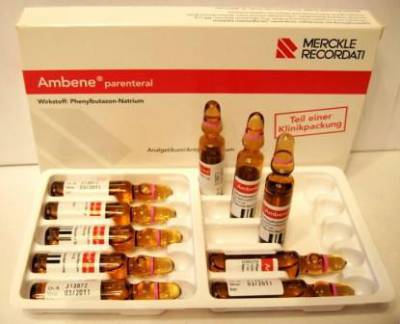
Ambene - complex preparation in injections with exacerbation of cervical osteochondrosis
Secondary injections
Drugs from this group do not eliminate pain and inflammation, but they can speed up the healing process. These include:
- B vitamins;
- chondroprotectors;
- diuretics;
- homeopathic remedies.
If it was not possible to eliminate the pain with the injections described above, then they resort to anesthetic blockades, in which local anesthetics and other drugs are injected paravertebrally (into the focus of inflammation). This technique can effectively eliminate pain and improve the patient's well-being.
Vertebral diseases- the scourge of modern society, and recently there has been a tendency of their "rejuvenation"... More and more young people and girls are exposed to the negative impact of this disease and suffer from the consequences. This material will consider such pathology as cervical osteochondrosis, symptoms and treatment, injections during the course of the lesion.
Osteochondrosis of the cervical spine symptoms
The disease has several signs, and you should definitely pay attention to the nature of their course in order to possess information about the subtleties of the therapeutic process.
- Pain in the neck and shoulders, it can be given to the arm. If a person is exposed to minimal physical exertion, these troubles intensify. It could be a cough or sneeze.
- The person with the disorder develops a crunching sound and pain in the neck when they try to tilt or turn their head.
- Numbness appears in the upper and lower extremities, as well as a slight tingling sensation. A severe burning sensation begins between the shoulder blades.
- The pain process starts in the occiput, and then gradually spreads to the temporal and parietal parts.
- The patient experiences headache and dizziness. In a number of situations, fainting and a feeling of stuffiness, weakness, apathy.
- In addition, a person suffers from noise sensations in the ears, deterioration of hearing function, pain in the heart region.
Osteochondrosis of the cervical spine has numerous symptoms and is a dangerous ailment. Therefore, it is important to start treating the disease in a timely manner.
What is the most effective injection for osteochondrosis
Injections are indicated in the case of an acute time course of pathology, but there is another indication characterized by severe pain... But the selection of the option, which injection for osteochondrosis will be the best, is dealt with by a strictly treating specialist. There is several weighty arguments give preference to injection therapy:
- a high rate of action due to the presence in the composition of active compounds that instantly enter the bloodstream and reach the nerves;
- a high probability of accurate selection of the dosage, because the entire dose has an effect on the syndrome, while when taking pills - only a part of it;
- the possibility of direct impact on the lesion focus of the pathological process, due to the particularly convenient method of administration of the agent;
- through uniform and long-term drug treatment you can achieve a good result compared to other medicines.
Studying the ailment of cervical osteochondrosis, symptoms and treatment, injections, it is worth noting that the effectiveness of the therapeutic process is traditionally determined by the doctor.

How and what kind of injection to give in case of illness
If a person is faced with a severe attack of pain, the most convenient way to recover will be the introduction of the medicine under the skin. The complex of drugs usually includes intramuscular injections of a fortifying and anti-inflammatory effect.
- Analgesic techniques... Most often, for medicinal purposes, formulations such as Analgin and Baralgin... Through an injection, you can eliminate the pain syndrome and improve the condition. The spasms of the skeletal muscles will be eliminated, and the person will feel much better. Also, within the framework of this complex, several medicines non-steroidal action.
- Blockades... In this case, the injections are pricked into the place that was affected, while the presence of pain syndrome acts as a direct indication. The procedure is quite simple and provides an immediate effect. Thus, an obstacle to the propagation of impulses is provided, the spasm goes away, the inflammation stops. The agents are widely used and include a wide variety of formulations.
In spite of a large number of pharmaceutical products, a specialist should prescribe and give an injection!
Osteochondrosis of the cervical spine treatment
Injections are not the only therapy in case of progression of this pathology. A whole complex treatment measures aimed at eliminating pain and putting the neck in order. Studying an ailment such as cervical osteochondrosis, symptoms and treatment, injections, you should pay attention to all measures and methods. Some of the most common practices are:
- resonance wave therapy involves influencing the aquatic organism by means of electromagnetic waves;
- acupuncture allows you to influence lesions and eliminate pain syndromes quite simply;
- injections act as an effective therapeutic method for eliminating ailments of the musculoskeletal system;
- use of simulators- another efficient way improving well-being to increase limb mobility;
- massage actions are aimed at the impact of the site of localization of pain and its natural discharge;
- reception medications allows to eliminate pain and improve the condition;
- folk remedies can act as effective supportive measures to combat any group of pathological processes.

If osteochondrosis is diagnosed cervical spine, treatment should be selected depending on the individual characteristics of the attending physician.
Cervical osteochondrosis medication list
Medicines, according to their action and method of use, can be classified into several main groups, each of which has personal benefits.
- Tablets... Traditionally, they are intended for long-term use as courses in case of exacerbation of pathology. Most often, the doctor recommends taking Analgin, Indomethacin, Chondroxide, Amitriptyline. But it is necessary to strictly adhere to the recipe in terms of the dosage regimen and dosage characteristics.
- Injections... We have already said that solutions of this kind are stronger and more effective. Most often, a specialist in the field of medicine prescribes Ortofen, Ketonad, group B vitamins. Again, you must be careful and use these medicinal formulations correctly.
- Local drugs... Most often, the patient has several concomitant pathologies that impose a ban on internal drug intake. Therefore, preference is given to creams, gels, ointments. The most effective means-, Voltaren, Finalgon, Traumeel, Nikoflux.
So, if cervical osteochondrosis is diagnosed, the list of medications suggests a fairly large one.
The consequences of the course of this disease
The pathological process is favorable in the case of timely detection of signs and referral to a specialist. Only a physician can prescribe truly high-quality products and determine dosages on an individual basis. Therefore, in general, if the rules of treatment are followed, the prognosis remains favorable. As for more serious complications, they occur in 10% of situations.... In this case, the consequences imply the transition of the disease to a new stage and the need to take cardinal therapeutic measures.
Thus, we examined what cervical osteochondrosis is, symptoms and treatment, injections. A competent approach to the implementation of therapy will allow achieve a good result... You can read reviews on this topic or write your opinion on the forum about treatment with folk remedies.
Every year more and more people come to medical institutions with paroxysmal, severe back pain. Diagnosed by a doctor - osteochondrosis lumbar... Lumbar osteochondrosis affects both men and women equally. There are many techniques and preparations for strengthening the spine, including for eliminating disturbing symptoms. One of these is the treatment of osteochondrosis with injections. It is the injections that are injected that help block and eliminate pain.
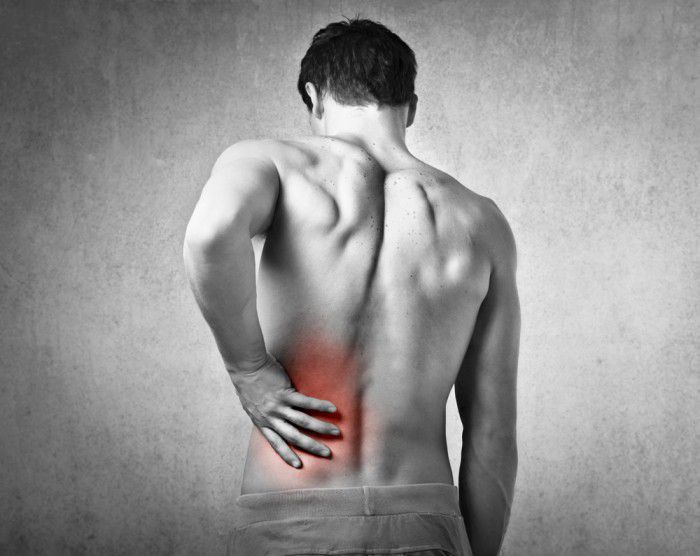
Every year more and more people come to medical institutions with paroxysmal, severe back pain. The doctor's diagnosis was osteochondrosis of the lumbar spine. Lumbar osteochondrosis affects both men and women equally. There are many techniques and medications for strengthening the spine and for relieving bothersome symptoms. One of these is the treatment of osteochondrosis with injections. It is the injections that are injected that help block and eliminate pain.
Osteochondrosis of the lumbar spine can contribute to the syndrome of intermittent claudication, when at the time of lack of blood supply in the lower parts spinal cord while walking, there is a feeling of powerlessness in the legs, numbness of the trunk.
Types of injections for osteochondrosis
For the treatment of lumbar osteochondrosis with injections, it is required to determine the patient's condition, the prescribed drug and the purpose of its administration. Most often, injection methods are divided into: intramuscular, intravenous, epidural and subcutaneous. For osteochondrosis of the spine, epidural injections are used. Novocaine injections and anesthetics block pain. The treatment has a quick effect on the nervous system. With the introduction of corticosteroid drugs at the site of the lesion, the positive effect will not be long in coming, and the inflammation will be relieved.
Treatment of osteochondrosis of the lumbar spine
There are a number of drugs for temporary and permanent use during the treatment of the lumbar spine:
- homeopathy and vitamins;
- chondroprotectors;
- hormonal drugs - corticosteroids;
- antispasmodics;
- pain relievers;
- non-steroidal anti-inflammatory.
Homeopathic injections and vitamin complex
The first and safe to use for osteochondrosis are injections based on natural preparations. They improve the condition of the spine, help reduce pain, and have virtually no side effects. They also allow you to draw additional resources for the body to replenish the loss of strength. Treatment usually lasts a long period of time, passing through an exacerbation stage.
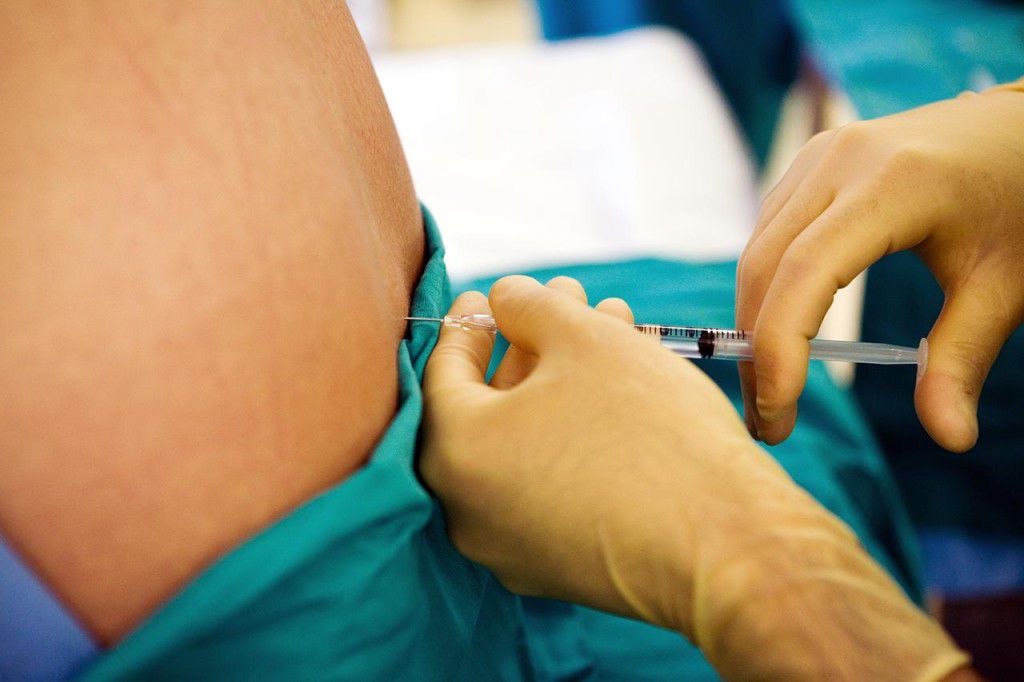
The vitamin complex from drugs of group B and PP is used in the form of subcutaneous and intramuscular injections. It helps to restore the injured sheaths of nerve fibers. This group includes drugs: Milgamma, Kombilipen.
In case of severe malaise, injections of Milgamma with an anesthetic for osteochondrosis of the lumbar spine can alleviate the general condition of the patient. Frequent use of vitamin complexes affects nerve cells, improving blood circulation and metabolism.
Chondroprotectors, hormonal drugs
To restore the cartilage tissue of the intervertebral disc, chondroprotectors are used to eliminate the signs of osteochondrosis. However, in order to maintain the result, rehabilitation may take up to 6 months. Chondroprotectors do not always help to restore tissue damaged by osteochondrosis due to dehydration of the body.
They also use drugs containing hormones - corticosteroids. They are used in the last stages of the disease, when PNP does not dull acute pain. According to the doctor's prescription, the treatment is divided into several courses. These kinds of hormonal injections quickly and effectively help, but do not exclude side effects that may appear over time.
Treatment with non-steroidal anti-inflammatory drugs
Vertebral osteochondrosis is most often treated with non-steroidal anti-inflammatory drugs, such as: Ketoprofen, Movalis, Ortofen, Meloxicam. Such injections relieve pain, reduce the severity of injury and block cyclooxygenase. It is the blocked enzyme, cyclooxygenase, that stimulates the production of prostaglandins, which are responsible for pain. Reaction to these agents for people susceptible to allergic reactions: they do not tolerate this treatment.
Movalis can be used with other medicines because it does not accumulate in the body. Injections with the drug Movalis for osteochondrosis reduce pain, relieve inflammation, and have an antipyretic effect. Side effects the drug is maximally reduced.
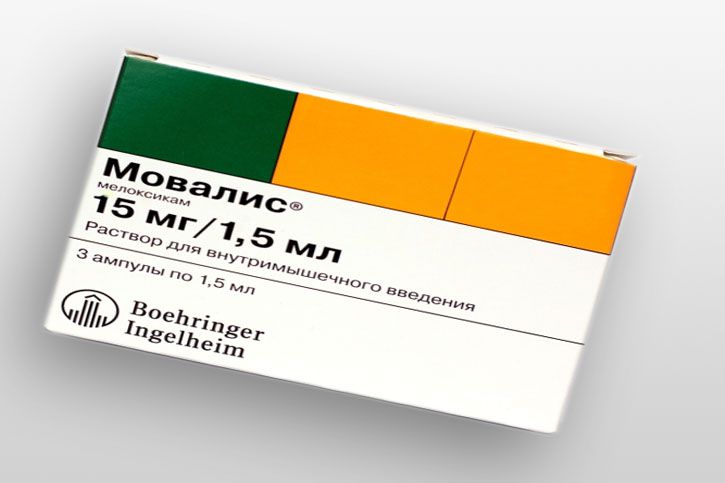
It is enough for Movalis to inject one injection per day intramuscularly. Movalis can be used for patients with various, several pathologies. Movalis is convenient to use both in tablets and in suppositories, and in ampoules. Like non-steroidal drugs, it can mask the symptoms of a major infectious disease.
Pain medications
During an exacerbation, the patient is treated with pain relievers that help relieve pain and alleviate the general condition. Most often, injections of Baralgin or Analgin are made intramuscularly. They only relieve pain, but they do not medicinal properties... If pain relievers do not help, then narcotic drugs are used: tarmadol.
Antispasmodic drugs
One of the modern means of muscle relaxants is antispasmodic drugs: mydocalm. It relieves spastic pain, reduces the stage of muscle contraction. With osteochondrosis of the lumbar region, severe muscle spasms, this kind of remedy is used as injections.
Physiotherapeutic methods
For the treatment of osteochondrosis of the lumbar spine, traditional physiotherapy is used:
- the lesion is affected by variable sinusoidal currents - an amplipulse;
- into the tissue with the help of ultrasound is introduced medicinal product- phonophoresis;
- exposure to high-frequency currents and diadynamic currents.
The primary task in osteochondrosis is treatment in a specialized clinic: elimination of pain, numbness. Osteochondrosis of the lumbar spine, perhaps, subject to alternative medicine: Eastern, Tibetan, Mongolian, which can act on the affected area by massage, heating. Osteochondrosis, according to scientists, most often occurs as a result of natural aging of the body.
